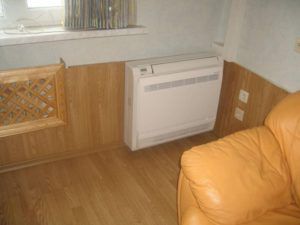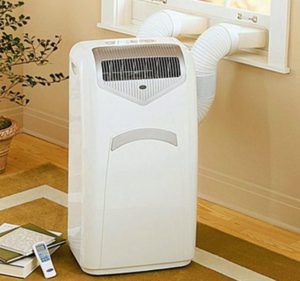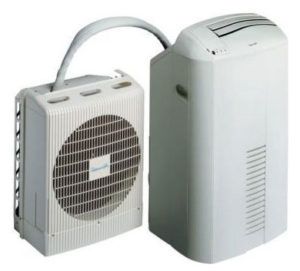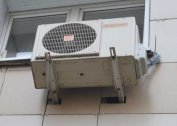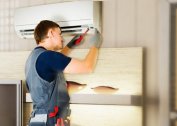A mobile air conditioner is an ideal way out of situations where an air conditioner is required, but it is not desirable or impossible to install a stationary air conditioner. For example, in a building that is rented out. The same issues with the installation of an air conditioner (even in your apartment) may arise when the house has historical or cultural value. In this case, local authorities can prohibit any change in the walls of the facade of the building, that is, the installation of various external devices (air conditioners, satellite dishes).
Features of mobile air conditioners
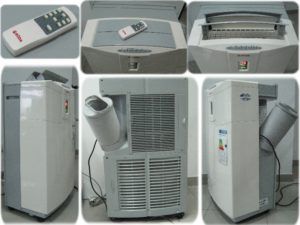 It is necessary to clearly realize that mobile floor air conditioning is a compromise equipment, all the main advantages of this portable equipment in an apartment are that it can be installed in houses in which conventional split systems are not available.
It is necessary to clearly realize that mobile floor air conditioning is a compromise equipment, all the main advantages of this portable equipment in an apartment are that it can be installed in houses in which conventional split systems are not available.
The advantages of mobile air conditioners are as follows:
- Do not need laborious installation work, everything can be done with your own hands. Moreover, this is true for apartments with recently made repairs;
- mobility. At its core, a mobile air conditioner is better defined as "relatively mobile." Since it will not work to install and enjoy the cold air, it is still necessary to do a certain process of preparation work, although, of course, not such a volume, in contrast to the installation of high-grade climate equipment;
- do not require coordination of installation, which is quite relevant for buildings that are rented;
- no utilities for supplying freon and condensate.
But mobile air conditioners also have disadvantages:
- this type of equipment does not have a drainage system. But condensate in the air conditioner still forms, and a special container drains at the bottom of the device, and from there it is necessary to pour out the water periodically;
- all mechanical elements, including the compressor, are located inside the building. At the heart of each air conditioner is a compressor. The compressor activates the refrigerant, “taking” heat from the freon, and draws out cold air. But at the same time, the compressor has a very loud noise, and just like any mechanics, it creates thermal processes during operation, the mechanical device of the air conditioner is also no exception;
- air for cooling is sucked directly from the room, thus, one stream of air passes repeatedly through the cooling system, which negatively affects the mechanical performance of the equipment;
- A mobile air conditioner is necessarily equipped with an air duct, with the help of it warm air is taken out of the apartment. Despite its thermal insulation, the duct remains very hot anyway, which, again, leads to heating of the air inside the apartment;
- Mobile air conditioning “steals” a certain area of the room in which it is installed, which is even more critical for small rooms.
All this applies, first of all, to the so-called monoblock mobile structures.
The two main elements of each HVAC system are a condenser and an evaporator. These devices are a design of radiators connected to each other, through which freon constantly passes. In the evaporator, the processed freon is converted into a vaporous form, “removing” heat from the room, and in the condenser, on the contrary, heat is transferred to the air. In floor-mounted monoblock devices, both systems are installed in one unit, which is located inside the room.
Another design feature of mobile climate control equipment is a split system. This type of air conditioner has a design of several systems, an indoor and outdoor unit. These split systems are devoid of many shortcomings, unlike monoblocks, but at the same time they get a significant drawback - they are quite expensive. The split system of this type in its performance is significantly inferior to the classic equipment of the same price category, even if you do it yourself (in addition to very difficult cases when you need to install the air conditioner correctly).
Installation of a mobile air conditioner
Installation of outdoor mobile equipment is much simpler, unlike other types of climatic devices. But if they say that: "mobile outdoor equipment does not need to be installed at all" - this is also wrong. Just mobile devices can be of several types - split systems or monoblock designs. And in these devices, the compressor is located in the unit, which is placed inside the room. At the same time, in the split system, the fan and condenser are in the external unit, and they are connected to each other by a thin tube, in which the system with the refrigerant is located.
During the installation of a mobile device with your own hands, it is necessary to observe certain nuances of installation:
- Do not connect the equipment to the power supply using an adapter or extension cord;
- the air conditioner must only be connected to an outlet that has grounding;
- Do not ground the climate equipment using a gas pipeline;
- do not turn on the device if the protective grille or panel of the indoor unit is removed;
- after installing the equipment, it is necessary to provide easy access to the plug;
- do not put the fuse in the neutral position or on the grounding cable, otherwise the air conditioner will “shock”;
- there should be no obstruction of air circulation near the equipment, the distance from the device to any objects must be at least half a meter;
- It is forbidden to install floor air conditioning in the bathroom, as well as outside the living room.
Monoblock mounting
There are several installation methods:
- The air exhaust pipe is installed through an ajar door.
- The air exhaust pipe is installed through a transom or an open plastic window.
Installation steps:
- Install the condensate drain hose in an elastic duct (certain monoblock designs are not equipped with a hose, but with an installed condensate outlet tank).
- Connect the air duct to the exhaust hole of the equipment.
- Install the other end of the duct (where the nozzle usually fits) into the window or doorway.
Important! Before turning on the air conditioner, it is obliged to stand upright for at least 3 hours, that is, in its normal condition.
Mobile split system
This type of equipment has a higher power, unlike a monoblock.
There are 3 installation methods:
- The outdoor unit of equipment is mounted in the utility room.
- The outdoor unit is mounted on the terrace.
- The outdoor unit of equipment is installed outside the window using straps or fastened with brackets.
Steps for installing a split system
Indoor unit installation
This unit is equipped with wheels and can easily move around the apartment. Any objects must not obstruct the air circulation through the air intake panel of the device.
Installation and mounting of the external unit
The best place for this block is a place that provides normal and properly organized conditions for heat exchange, for example, a veranda, a loggia or a window. Between the outdoor unit of equipment and the wall or the second unit must be a distance of not less than 6 centimeters.
Fixing the unit is not considered a mandatory rule.This mobile equipment can be installed simply on the floor or on some flat surface that will not allow water leakage. In the case of floor-mounted installation of the unit, it must be securely fixed to the base with four rollers, this will facilitate the movement of the structure. To complete the installation, special support brackets are provided in the kit, which provide mounting of the unit to the wall.
For wall mounting of the external unit, you need to make holes in the wall, install dowels in them and fix the brackets. Then the external block is put on them and fixed. Be sure to make sure it is securely locked!
Mobile air conditioners are a truly innovative solution in the field of HVAC equipment. Almost instant cooling of the air in the room, inexpensive cost, ease of installation and ease of further operation - the main advantages of acquiring this system, both for the office and for home use, are probably obvious.
